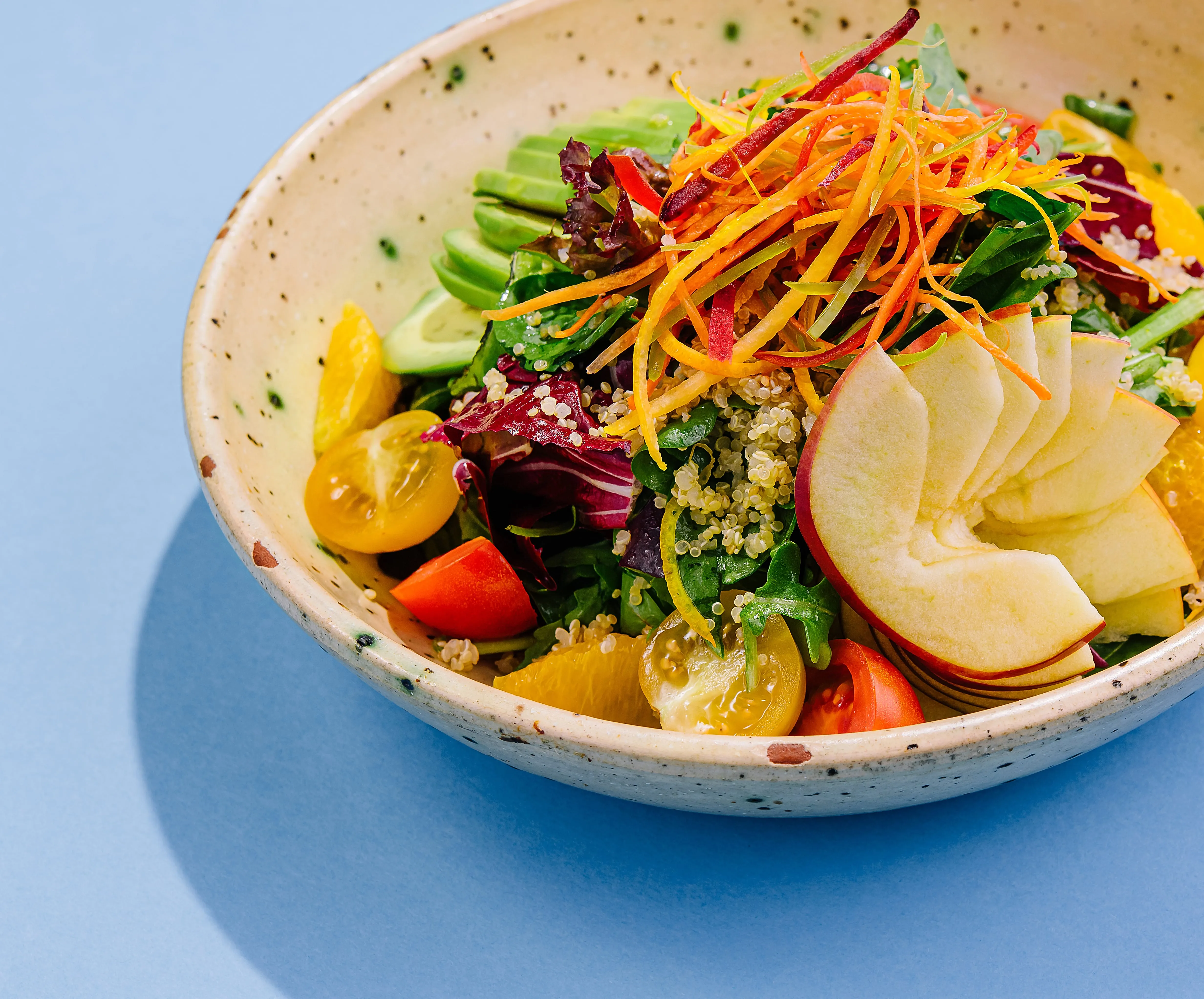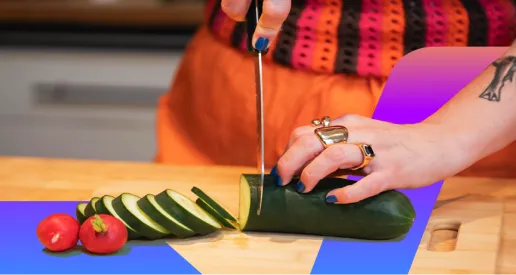Key Takeaways
- Even nutritious foods like fruits, grains, and starchy vegetables can cause blood sugar spikes, depending on portion size, prep method, and even your genes.
- Tools like continuous glucose monitors and food journaling can help you understand your unique responses.
- Pairing carbs with protein, fiber, and healthy fats, choosing lower-glycemic options, and adjusting how foods are prepared can help improve blood sugar control.
{{mid-cta}}
You load up on brown rice, toss avocado into your salad, and drizzle a little honey in your tea. These are all foods and habits that are generally labeled “healthy," but then you check your glucose monitor and... spike. What gives?
It’s a common surprise: Even so-called “healthy” foods can raise blood sugar levels, sometimes sharply. This doesn’t mean these foods are off-limits, but it does mean they may need a little more context and balance, especially if you're managing type 2 diabetes, prediabetes, or just trying to stay in a healthier range.
Here, we break down why some nutritious foods can spike blood glucose, how to identify your own patterns, and smart strategies to help you stay in control without giving up the foods you love.
What Causes Glucose Spikes from Healthy Foods?

Even whole, natural foods can lead to blood sugar spikes under certain conditions. Here's what happens and how to minimize the effect.
1. Natural Sugars and Starches
Many fruits, vegetables, and grains contain natural sugars and carbohydrates, which your body breaks down into glucose for energy. That’s not inherently bad (glucose is essential), but some foods release it into the bloodstream faster than others. The quicker the release, the sharper the spike.
For instance, pineapple or a bowl of white rice can cause a rapid rise in glucose compared to slower-digesting, fiber-rich options like cruciferous vegetables (broccoli, cauliflower, etc.) and leafy greens (spinach, kale, etc.).1
2. Portion Size and Meal Composition
Even nutrient-dense foods can cause blood sugar spikes if eaten in large portions or without the right balance of nutrients. Meals that lack protein, healthy fats, or fiber digest faster and lead to more pronounced glucose responses.
Take quinoa (which is carb-rich), for example. On its own, it may spike your glucose, but when paired with grilled chicken and fiber-rich roasted vegetables roasted in olive oil, the overall effect is gentler. Protein, fats, and fiber work together to slow digestion and blunt the glucose response. 4
3. Timing and Metabolic Content
Your body’s ability to handle glucose changes depends on factors like time of day, stress levels, sleep, and recent activity. You are generally more insulin sensitive (better able to manage your blood sugar) in the morning and after any type of movement.
The same banana might cause a higher spike late at night or after poor sleep than it would earlier in the day or after a walk, even though the food itself hasn’t changed.
4. How the Food is Prepared (and When It’s Eaten)
Cooking and cooling certain foods, like potatoes, rice, or pasta, can change their chemical structure and create resistant starch, a form of carbohydrate that resists digestion in the small intestine.
Studies show that resistant starch leads to a lower glucose response than freshly cooked versions of the same food. For example, cold or reheated rice may spike you less than hot rice straight from the pot. The change happens because resistance starch behaves more like fiber, feeding gut bacteria and slowing down glucose absorption.
Individual Metabolic Differences
Not all bodies react the same way to food… even when the meals are identical. That’s why personalization matters.
Here are a few key reasons your glucose response might look different from someone else’s:
1. Genetics and Insulin Sensitivity
Your DNA plays a role in how sensitive your cells are to insulin, the hormone that helps move glucose from your bloodstream into your cells for energy. If your body doesn’t respond well to insulin (a condition called insulin resistance), glucose can build up in the blood instead of being used efficiently. This is common in people living with prediabetes or type 2 diabetes. 5
2. Gut Microbiome
The trillions of microbes in your gut don’t just affect digestion; they also impact how your body processes carbs. Research shows that even when people eat the same foods, their blood sugar responses can vary widely depending on the composition of their gut microbiome. 6
3. Medications and Existing Conditions
Certain medications can interfere with blood sugar control. These include corticosteroids, beta-blockers, alpelisib, some antipsychotics, and other drugs linked to elevated glucose or reduced insulin sensitivity. Underlying chronic conditions like PCOS, liver disease, and pancreatic disorders can also affect how your body regulates blood sugar. 7
4. Your Metabolic Context
Glucose response isn’t static; it changes based on what’s going on in your body. Sleep quality, stress levels, activity, and hormonal fluctuations can all influence how your body handles glucose from one day (or even one hour) to the next,
That’s why in-the-moment feedback matters; it helps you learn how your body responds today, not just in theory.
Common Healthy Foods That May Cause Spikes

Some foods that seem healthy (and often are, nutritionally) can still cause sharp glucose spikes, especially when eaten on their own or in large portions. Here’s why context and pairing matter.
Fruits
Fruit is packed with vitamins, antioxidants, and fiber, but some varieties hit your bloodstream faster than others.
Mango, pineapple, and watermelon are high in natural sugars and relatively low in fiber, which can cause a quick glucose rise. If you enjoy these, try eating smaller portions and pair them with protein or healthy fat to help slow absorption.
Lower-impact options include berries, apples, and pears; fruits that naturally come with more fiber and are digested more slowly.
Starchy Vegetables
Not all vegetables are created equal when it comes to blood sugar.
Corn, peas, and especially white Russet potatoes are starch-heavy and can lead to glucose spikes, particularly when eaten alone. For more stable options, go for non-starchy vegetables like broccoli, zucchini, or bell peppers.
Whole Grains and Legumes
Whole grains are often marketed as blood-sugar-friendly, but even options like brown rice or whole-grain breads can lead to spikes if eaten in large portions or without balancing nutrients like healthy fats or protein.
Legumes (like lentils or chickpeas) are rich in fiber and protein, but can still raise glucose for some people and may cause bloating or discomfort depending on your gut health
Natural Sweeteners
Just because something is “natural” doesn’t mean it won’t spike your blood sugar.
Honey, agave, coconut sugar, and maple syrup all have similar effects as table sugar when it comes to glucose. Use sparingly, and when possible, pair with fat or protein to help blunt the spike.
How to Identify Your Personal Responses

You don’t have to guess how your body responds to certain foods. With the right tools and a little curiosity, you can start spotting patterns and making smarter, more personalized choices.
1. Continuous Glucose Monitoring (CGM)
A continuous glucose monitor (CGM) provides in-the-moment feedback on how your body processes food, activity, sleep, and stress. This kind of insight helps you move beyond generic advice and uncover what actually works for you.
2. Food Journaling
Pairing a food log with your CGM data can help you connect the dots. Track what you ate, how much, when, and how you felt afterward. Over time, patterns become clear: the meals that keep you steady and the ones that spike you.
3. Experiment with Meal Timing and Food Combinations
Your body’s glucose response isn’t just about what you eat; it’s also about when and how you eat. Some people handle carbs better in the afternoon than in the morning. Others notice a big difference when they eat protein and fiber before carbs. Try small adjustments to your routine and watch how your body responds. With actual data, you’ll quickly learn what works best for your metabolism.
Strategies for Reducing Spikes from Healthy Foods

You don’t have to cut out carbs or avoid your favorite meals. With a few simple tweaks, you can keep your glucose steader and still enjoy the foods you love.
1. Pair Carbs with Protein, Fat, and Fiber
Eating carbs on their own often leads to a quick spike. But when you pair them with healthy fats (like avocados, healthy oils, or nuts), lean protein (like fish, chicken, and lean meat), and fiber (from starchy veggies and whole grains), digestion slows down and so does the glucose response.
This combination helps keep energy steady and cravings at bay.
2. Choose Lower-Glycemic Options
Reach for slow-digesting carbs like quinoa, barley, lentils, or steel-cut oats instead of refined grains or processed snacks. These options raise blood sugar more gradually and tend to keep you fuller longer..
Bonus: They also deliver more fiber, vitamins, and minerals per bite.
3. Be Mindful of Portion Sizes
Even healthy carbs can spike you in large amounts. One cup of brown rice might work well for your body, but doubling or tripling that portion can change the equation fast.
Try scaling portions to match your activity level or pairing carbs with movement (like a short walk after eating) to help your body handle them better.
4. Cook, Cool, and Reheat Starches
When certain carbs, like rice, pasta, or potatoes, are cooked, cooled, and then reheated, they form resistant starch. This type of starch is digested more slowly and may lead to a lower glucose response.
Leftovers might actually be your blood sugar’s secret weapon.
When to Consult a Healthcare Professional
Sometimes, glucose spikes aren’t just food-related. Here's when it might be time to schedule a doctor's visit.
1. You Have Persistent or Unexplained Spikes
If you’re noticing spikes despite eating balanced meals, it’s worth talking to your healthcare provider. You may need testing for insulin resistance, prediabetes, or even underlying conditions affecting your pancreas or blood vessels.
2. You're Noticing Symptoms of Blood Sugar Imbalance
Having blood glucose levels that are too high or too low can cause symptoms like cravings, fatigue after meals, frequent urination, or feeling shaky. These are two separate conditions that are treated differently, but both require medical attention.
The Bottom Line
Even “healthy” foods can cause glucose spikes depending on your body, the way you eat them, and how they’re prepared. Instead of giving up these foods, use tools to track your body's glucose responses and make simple tweaks to meals, such as reducing portion sizes and pairing carbs with healthy protein and fats.
Learn More With Signos’ Expert Advice
Want to dive deeper into understanding your body’s response to food? Signos can help you make smarter choices by connecting nutrition insights with your personal health data. Learn more about glucose levels on the Signos blog.
Topics discussed in this article:
References
- https://www.arheart.com/wp-content/uploads/2024/02/2020.10.06-Glycemic-Index-Handout.pdf
- https://blogs.ifas.ufl.edu/pascoco/2022/11/01/glycemic-index-and-glycemic-load/
- https://pubmed.ncbi.nlm.nih.gov/26693746/
- https://www.merckmanuals.com/home/disorders-of-nutrition/overview-of-nutrition/carbohydrates-proteins-and-fats#Carbohydrates_v60557845
- https://pmc.ncbi.nlm.nih.gov/articles/PMC314334/
- https://pmc.ncbi.nlm.nih.gov/articles/PMC10732577/
- https://pmc.ncbi.nlm.nih.gov/articles/PMC11330434/




.svg)










.svg)
.svg)
.svg)
.svg)
.svg)
.svg)
.svg)
